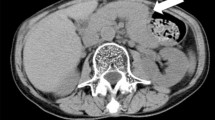Abstract
Amanita phalloides-type mushroom poisoning is well recognized as causing acute liver injury and often death. Less is known, however, of whether maternal Amanita poisoning is associated with fetal damage or not. In August 1991 four members of a family were hospitalized with food intoxication caused by Amanita phalloides and Amanita verna. One of them died from hepatic and renal failure. The survivors included a 26-year-old woman in the 23rd week of pregnancy. Her clinical symptoms and blood chemistry data (lowest prothrombin activity 23%) indicated intoxication of medium severity. The management consisted of i.v. hydration, forced diuresis, and administration of silibinin, high-dose penicillin, thioctic acid, hydrocortisone, vitamin K, and fresh frozen plasma. Sonographic and obstetric controls failed to show any fetal abnormalities in the acute phase of poisoning. In the 38th week of pregnancy she gave birth to a healthy baby, who has subsequently undergone an undisturbed development. This observation indicated that severe fetal damage did not occur in maternal Amanita poisoning in the second trimester of pregnancy. Thus, at least from the second trimester on, maternal Amanita poisoning is not necessarily an indication for induced abortion.
Similar content being viewed by others
Abbreviations
- ALAT:
-
alanine aminotransferase
- BPD:
-
biparietal diameter
- FOD:
-
fronto-occipital diameter
- US:
-
ultrasonography
References
Alder AE (1961) Erkennung und Behandlung der Pilzfergiftungen. Dtsch Med Wochenschr 86:1121–1127
Bartoloni St Omer F, Giannini A, Botti P, Caramelli L, Ledda F, Peruzzi S, Zorn M (1985) Amanita poisoning: a clinical-histopathological study of 64 cases of intoxication. Hepatogastroenterol 32:229–231
Belliardo F, Massano G, Accomo S (1983) Amatoxins do not cross the placental barrier. Lancet 1:1381
Buck RW (1961) Mushroom toxins — a brief review of the literature. N Eng J Med 265:681–686
Dilts, PV jr (1987) Drugs in pregnancy. In: Berkow R (ed) The Merck manual of diagnosis and therapy. Merck, Rahway, pp 1752–1755
Fantozzi R, Ledda F, Caramelli L, Moroni F, Blandina P, Masini E, Botti P, Peruzzi S, Zorn M, Mannaioni PF (1986) Clinical findings and follow-up evaluation of an outbreak of mushroom poisoning — survey of Amanita phalloides poisoning. Klin Wochenschr 64:38–43
Faulstich H (1979) New aspects of Amanita poisoning. Klin Wochenschr 57:1143–1152
Faulstich H, Kommerell B, Wieland T (eds) (1980) Amanita toxins and Amanita poisoning. Witzstrock, New York
Floersheim GL, Weber O, Tschumi P, Ulbrich M (1982) Die klinische Knollenblätterpilzvergiftung (Amanita phalloides): prognostische Faktoren und therapeutische Massnahmen. Schweiz Med Wochenschr 112:1164–1177
Galler GW, Weisenberg E, Brasitus TA (1992) Mushroom poisoning: the role of liver transplantation. J Clin Gastroenterol 15:229–232
Guarino AM (1979) Pharmacologic and toxicologic studies of anticancer drugs. In: DeVita VT Jr, Busch H (eds) Methods in cancer research, vol XVII. Academic Press, New York, pp 92–174
Kaufmann M, Müller A, Paweletz N, Haller U, Kubli F (1978) Fetale Schädigung bei einer Knollenblätterpilzver-giftung der Mutter in der Frühschwangerschaft. Geburtsh Frauenheilk 38:122–124
Klein AS, Hart J, Brems JJ, Goldstein L, Lewin K, Busuttil RW (1989) Amanita poisoning: treatment and role of liver transplantation. Am J Med 86:187–193
Kröncke KD, Fricker G, Meier PJ, Gerok W, Wieland T, Kurz G (1986) α-Amanitin uptake into hepatocytes. Identification of hepatic membrane transport system used by amatoxins. J Biol Chem 261:12562–12567
Molnár-G B, Gyöngyösi J, Kovács L (1982) Relations between the weight and lenght data of newborns and the gestation period in the population of Szeged and its surroundings. Demográfia 25:337–344 (in Hungarian)
Parish RC, Doering PL (1986) Treatment of Amanita mushroom poisoning: a review. Vet Hum Toxicol 28:318–322
Slodkowska J, Szendzikowski S, Stetkiewicz J, Muszynski J (1980) Histological picture and mechanism of development of the liver changes in poisoning with Amanita phalloides. Patol Pol 31:55–66
Szamosi J, Kovacs I (1981) On the lethality of amanitin-type mushroom poisoning. Orv Hetil 122:2987 (in Hungarian)
Vesconi S, Langer M, Iapichino G, Constantino D, Busi C, Fiume L (1985) Therapy of cytotoxic mushroom intoxication. Crit Care Med 13:402–406
Wieland T (1983) The toxic peptides from Amanita mushrooms. Int J Peptide Protein Res 22:257–276
Wieland T, Faulstich H (1991) Fifty years of amanitin. Experientia 47:1186–1193
Author information
Authors and Affiliations
Additional information
Correspondence to: I. Nagy
Rights and permissions
About this article
Cite this article
Nagy, I., Pogátsa-Murray, G., Zalányi, S. et al. Amanita poisoning during the second trimester of pregnancy. Clin Investig 72, 794–798 (1994). https://doi.org/10.1007/BF00180549
Received:
Revised:
Accepted:
Issue Date:
DOI: https://doi.org/10.1007/BF00180549




